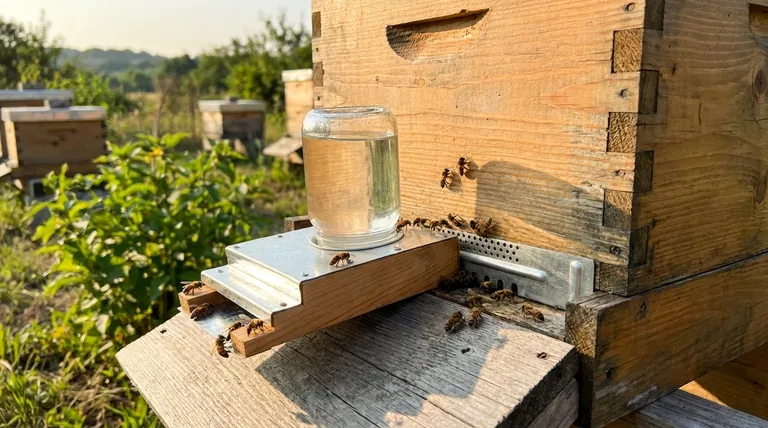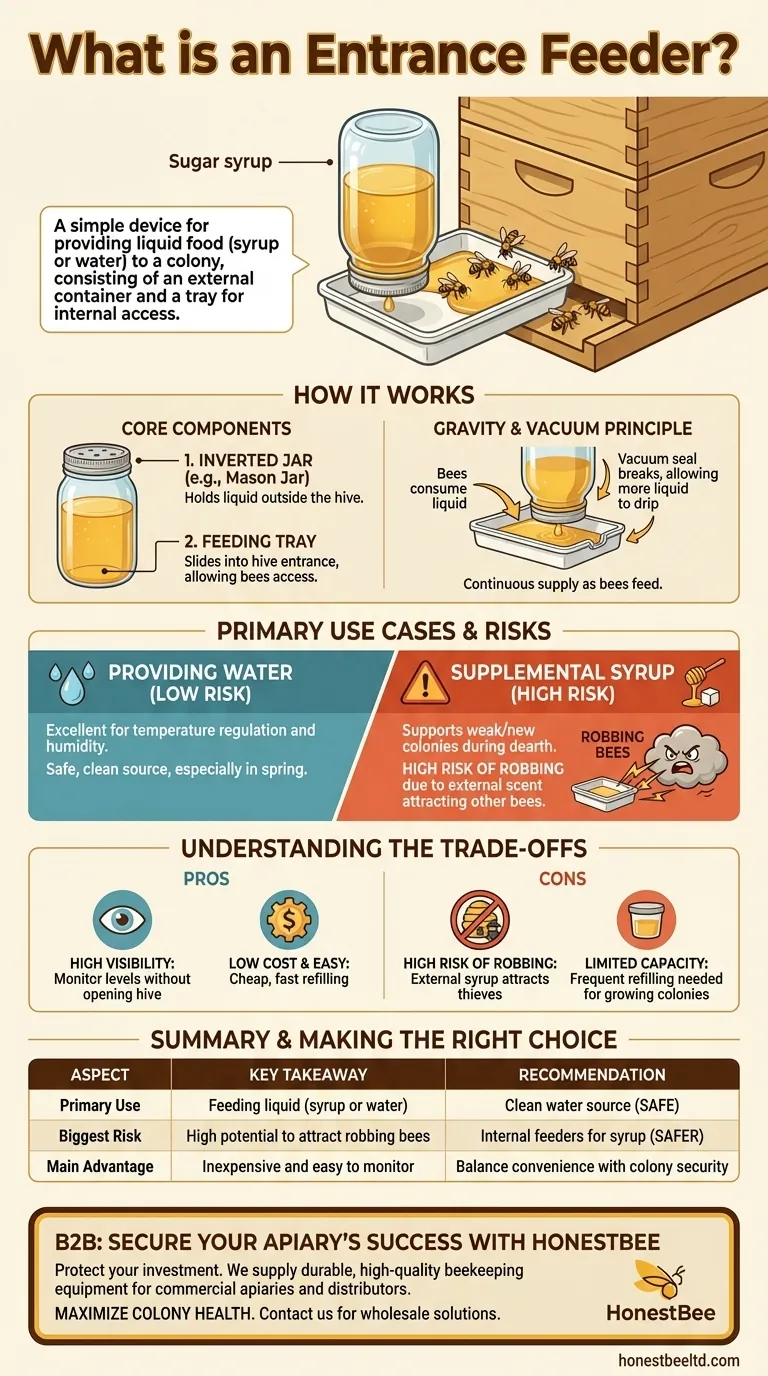In beekeeping, an entrance feeder is a simple device used to provide liquid food to a honey bee colony. It consists of two main parts: a container, typically a glass jar, that holds the liquid outside the hive, and a plastic or wooden tray that slides into the hive's entrance, allowing bees to access the food.
While entrance feeders are inexpensive and easy to monitor, their placement at the hive entrance makes them highly susceptible to attracting bees from other colonies, a serious risk known as robbing.

How an Entrance Feeder Works
An entrance feeder, also known as a Boardman feeder, operates on a simple gravity and vacuum principle. Its straightforward design makes it a common choice for new beekeepers.
The Core Components
The feeder has two parts. The first is an inverted jar (often a standard mason jar) with small holes in its lid, which holds sugar syrup or water.
The second part is a feeding tray that the jar screws into. This tray has a long, narrow platform that slides directly into the main entrance of the hive.
The Feeding Mechanism
As bees consume the liquid from the channel inside the hive, the vacuum seal in the jar is broken. This allows a small amount of liquid to drip from the jar onto the tray, refilling it for the bees.
The Primary Use Cases
Entrance feeders serve two distinct purposes, one of which carries significantly more risk than the other.
Providing Water
Bees require water to regulate hive temperature and humidity, and to dilute honey for feeding larvae. An entrance feeder is an excellent, low-risk tool for providing a clean water source, especially in early spring.
Supplemental Syrup Feeding
The more common use is feeding sugar syrup. This is done to support a new colony, help a weak hive build up strength, or provide food during a nectar dearth when natural forage is scarce.
Understanding the Trade-offs
The simplicity of the entrance feeder comes with significant advantages and critical disadvantages that every beekeeper must weigh.
Pro: High Visibility
Because the jar is outside the hive, you can see the liquid level at a glance. This allows you to monitor consumption rates and know exactly when to refill it without disturbing the colony.
Pro: Low Cost and Ease of Use
Entrance feeders are among the cheapest feeders available. Refilling is fast and simple—you just unscrew the old jar and screw on a new one.
Con: High Risk of Robbing
This is the feeder's most significant drawback. The external placement and scent of sugar syrup can easily attract robbing bees from stronger, nearby hives. This can trigger a frenzy where the robbing bees invade the hive to steal its resources, often resulting in the death of the colony.
Con: Limited Capacity
Most entrance feeders use a standard quart jar. For a growing colony in need of substantial feeding, this small volume requires frequent refilling, sometimes daily.
Making the Right Choice for Your Bees
Your decision to use an entrance feeder should be based on your specific goal and your awareness of the risks involved.
- If your primary focus is providing a clean water source: An entrance feeder is an excellent and safe choice.
- If your primary focus is feeding syrup to a weak or new colony: An internal feeder (like a frame or top-hive feeder) is a much safer option that eliminates the risk of robbing.
- If you must use an entrance feeder for syrup: Do so with extreme caution, ideally when no other hives are nearby, and monitor constantly for signs of robbing bees at the entrance.
Choosing the right feeder is about balancing convenience with the long-term security and health of your colony.
Summary Table:
| Aspect | Key Takeaway |
|---|---|
| Primary Use | Feeding liquid (sugar syrup or water) to a bee colony. |
| Best For | Providing a clean water source; syrup feeding only with extreme caution. |
| Main Advantage | Inexpensive and easy to monitor without opening the hive. |
| Biggest Risk | High potential to attract robbing bees from other colonies. |
| Recommended Alternative | Internal feeders (frame or top-hive) for safer syrup feeding. |
Secure Your Apiary's Success with the Right Equipment
While entrance feeders have their place, protecting your investment from robbing and other threats is paramount for a thriving operation. HONESTBEE supplies durable, high-quality beekeeping supplies and equipment designed for the needs of commercial apiaries and beekeeping equipment distributors.
We help you maximize colony health and productivity with wholesale-focused solutions.
Ready to strengthen your beekeeping business? Contact our team today to discuss your wholesale needs.
Visual Guide

Related Products
- Boardman Entrance Bee Feeder Durable Galvanized Steel and Wood Construction for Beekeeping
- Professional Hive Front Entrance Bee Feeder
- HONESTBEE Entrance Bee Feeder Professional Hive Nutrition Solution for Beekeeping
- HONESTBEE Entrance Bee Feeder Efficient Hive Front Liquid Feeding Solution for Beekeeping
- Classic Boardman Entrance Bee Feeder Hive Front Feeding Solution
People Also Ask
- How do you make an entrance feeder for bees? A Guide to Safe & Effective Hive Feeding
- Are entrance feeders good for bees? Prioritize Hive Health Over Convenience
- How to make an entrance feeder for bees? A DIY Guide for Safe & Effective Feeding
- What types of bee feeders are available for beginners? Start with the Simple Entrance Feeder
- What is an entrance feeder and how is it used? Avoid the Critical Risk of Robbing



















